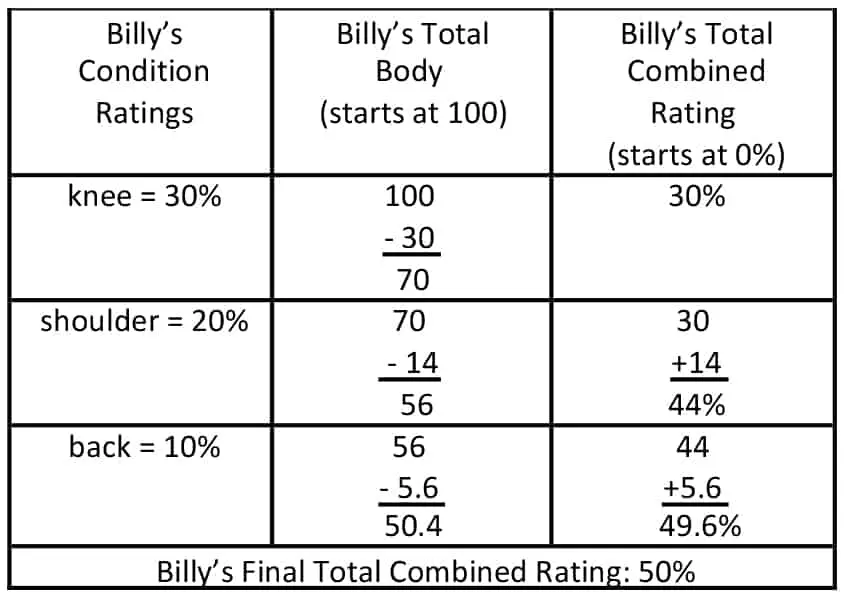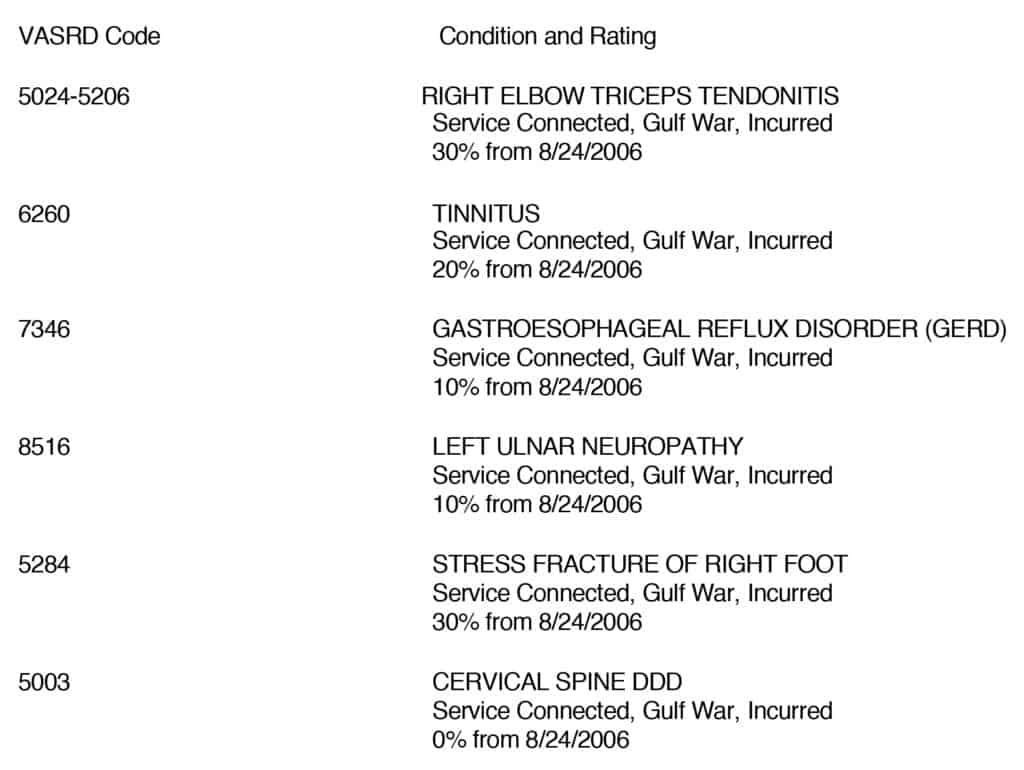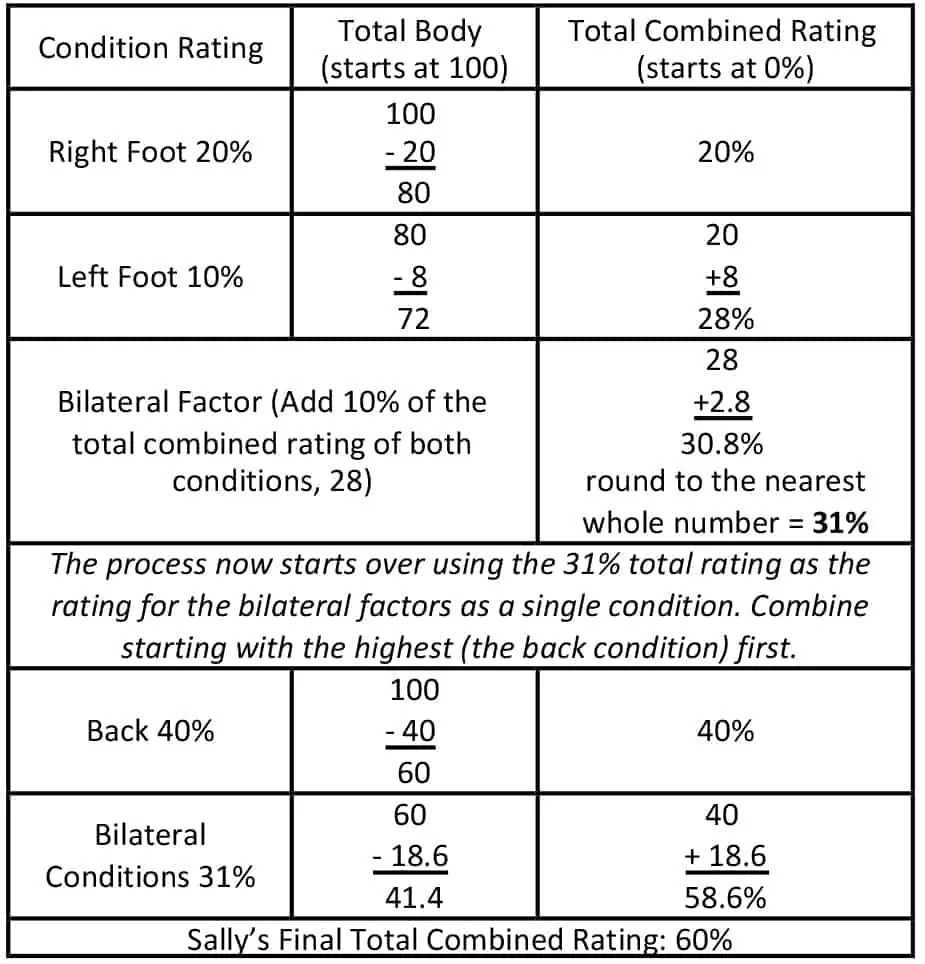VA Math
Topics:
Basic VA Math
The Bilateral Factor
Basic VA Math
Welcome to Mind-Boggling VA Math. Prepare yourself. Whoever thought of this was nuts! Seriously nuts.

That being said, Don’t worry! You’ll be fine! We’ll help you through VA Math step-by-step with a few examples. You should now feel very reassured and ready to face VA Math head-on.
Let’s start at the beginning. What is VA Math? VA Math is the math used to combine the Military Disability Ratings of multiple conditions to give a veteran a single overall, or “combined”, rating. In other words, if a person has more than one condition that is rated for Military Disability, then each of the ratings are combined (note that the key word here is “combined” not “added”) together using VA Math to give one overall rating. This single rating is then used to determine the exact type and amount of Military Disability Benefits the veteran receives.
VA Math is used for both DoD Disability and VA Disability.
So here’s how VA Math works. Each condition is a percentage of the disability of the service member. When combined together, however, each percentage is not a percentage of the entire service member but a percentage of what is left after other percentages have been subtracted. Got that? No? Well here’s an example:
Billy’s entire body is equal to 100%. Let’s say that Billy has three rated conditions. The first is a knee injury that is rated 30%. The second is a shoulder injury rated 20%. The last is a back injury rated 10%. Instinct would assume that the combined rating would be 60% (30 + 20 + 10 = 60). Unfortunately, that’s not the case with VA Math.
First start with the largest rating, 30%. This rating is then subtracted from the total body rating of 100%. Of the total body, now only 70% remains. So instead of simply subtracting 20 for the shoulder’s 20%, you can only subtract 20% of the 70 that is left, which is 14 (0.2 x 70 = 14). 70 minus 14 is 56. Now, since only 14 was subtracted from the total body, only 14 is added to the total combined rating. (Take a deep breath. Following along with the table below might help…)
Now for the last 10%. Again we can only subtract 10% of what is left of the total body. Thus, 10% of 56 is 5.6 (0.1 x 56 = 5.6). 56 minus 5.6 is 50.4. And again, since only 5.6 was subtracted from the total body, only 5.6 is added to the combined rating. So far, Billy’s rating is 30% + 14% + 5.6% = 49.6%.
Once all the conditions are counted, then the total combined rating is rounded to the nearest 10. 49.6%, therefore, equals 50% total disability.

Got VA Math now? If your answer is No, grab a pencil and a piece of paper and walk through the example above yourself. It really does help to do the steps yourself. If your answer is Yes, great! There’s more to come.
Depending on the veteran, the list of conditions can sometimes be pretty long, and the VA Math becomes even more confusing. So, here’s a more complex example. Remember, simply follow the format from the example above and focus on one condition at a time.
Michelle’s VA Rating Decision looks like the following:

VA Math time! Add the ratings from largest to smallest, regardless of the order they are listed on the Rating Decision, as follows:

Got it now? Well, we’re sure you’re doing great, and if this were an elementary math class, we’d give you a smiley sticker, but there’s one final kink to put into the VA Math equation.
Return to Top
The Bilateral Factor
An additional 10% (the “Bilateral Factor”) is added to the VA Math equation if the veteran has both arms, both legs, or all four limbs affected by ratable conditions.
Note: A Bilateral Factor is added when both arms or both legs have a rated condition, even if one of them is only rated 0%.
So, if there is a right knee condition and a left knee condition that are both rated, then you get an additional 10%. The point of the bilateral factor is to take into account the fact that if you have a problem in your right leg, then a problem in your left leg will just make it worse and vice-versa. It is easier to deal with a condition if the opposite part of your body can compensate.
That being said, the conditions do not have to be identical for the bilateral factor to apply. If you have a left hip condition and a right foot condition, you still get that extra 10% since each condition affects the opposite lower extremity. If there are four conditions, one affecting each of the four extremities, then all four ratings are combined before the bilateral factor is calculated and added.
Here’s the VA Math catch: The key to adding that extra 10% is that it is not a 10% as though it were another condition, but is 10% of the combined rating of the two (or more) bilateral conditions. Once those conditions are combined, then 10% of that value is added, and the group of bilateral conditions is then treated as a single condition and combined with any other conditions. (We’ve already agreed that whoever thought of this was nuts.)
If a bilateral factor is added, always calculate the bilateral factor with its conditions first, then rank the remaining conditions (the combined bilateral conditions now count as a single condition) from highest rating to lowest and continue with normal VA Math.
The Bilateral Factor will always be applied unless it results in a lower Total Combined Rating than would result if it were not added (very rare).
So, if Sally has three conditions, a right foot rated 20%, a left foot rated 10%, and a back rated 40%, the foot conditions would be combined first since they are bilateral, even though the back condition is rated higher. The bilateral factor is then added to the combined rating of the foot conditions. That rating is rounded to the nearest whole number and then becomes the rating of a single bilateral condition that is then combined with the remaining back condition.

As you can see, since all ratings are rounded to the nearest 10 at the end, the bilateral factor may not be very helpful in raising the overall rating. In this case, Sally would have received 60% even without the bilateral factor. But in other cases it may make a critical difference. Consider the example below which is only slightly different from Sally’s case.
Marcus has three conditions, a right shoulder rated 20%, a left arm rated 20%, and a back rated 10%. The two arm conditions are combined first, and then the bilateral factor is added to their combined rating. That rating is rounded to the nearest whole number and then becomes the rating of a single bilateral condition that is then combined with the back condition.

Without the bilateral factor Marcus’ conditions would have combined to 43% which rounds down to 40% final rating. So, not only did the bilateral factor get Marcus a 10% higher rating, it also pushed him to the 50% rating that qualifies him for CRDP. That’s huge! Regardless, if you have two bilateral conditions, you get that extra 10%. Happy Birthday.
That’s it. You have passed your VA Math class. If you haven’t already, go Find Your Conditions so you can practice your VA Math! Woo-hoo!
Return to Top
FAQs
What is VA Math?
VA Math is the math used to combine the ratings of multiple conditions to give a veteran a single overall combined rating.
Do I need VA Math in my case?
If you only have a single medical condition that qualifies for disability, then no, you do not need VA Math. If, however, you have multiple conditions, then you will need to use this math to combine your conditions to get your single overall rating.
How does VA Math work?
Each condition is a percentage of the disability of the service member. When combined together, however, each percentage is not a percentage of the entire service member but a percentage of what is left after other percentages have been subtracted. Definitely follow along with our examples to fully understand this concept.
Why does the VA use this math system?
The VA needed a way to combine the ratings for various conditions to get the veteran's overall rating. VA Math was created to combine the ratings in a way that reflects the diminishing effect additional conditions have on a veteran's overall functioning and ability to work.
What is the bilateral factor?
The bilateral factor is an additional 10% that can be factored into your equation if you have two or more conditions that affect the opposite limbs (i.e. legs, arms). The idea is if you have one condition on your right leg and another on your left, those are going to make each other worse and ultimately cause a worse disability.
How does VA Math affect the benefits I receive?
In order to find your overall combined rating, you must use VA Math. Your combined rating is then used to assign your monthly payment amount using the VA Disability Chart.
What if my combined rating is wrong?
The VA has calculators that does VA Math for them, so it would be very rare to have the wrong combined rating, but not impossible (though we've never seen it). If, however, it happens in your case, you can call your Regional VA and see if they can fix it through their system.
Can I receive the bilateral factor for conditions in one arm and one leg?
No. The bilateral factor only applies if the opposite limbs are involved. Both legs or both arms. An arm and a leg condition are not considered bilaterals of each other.


